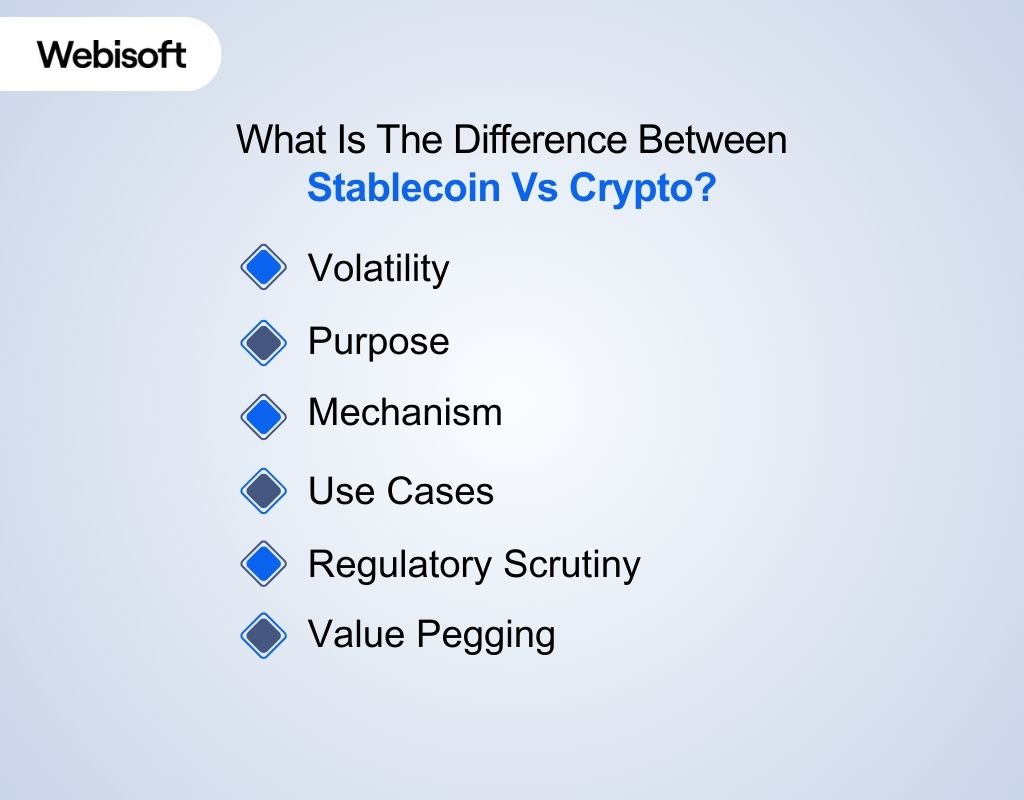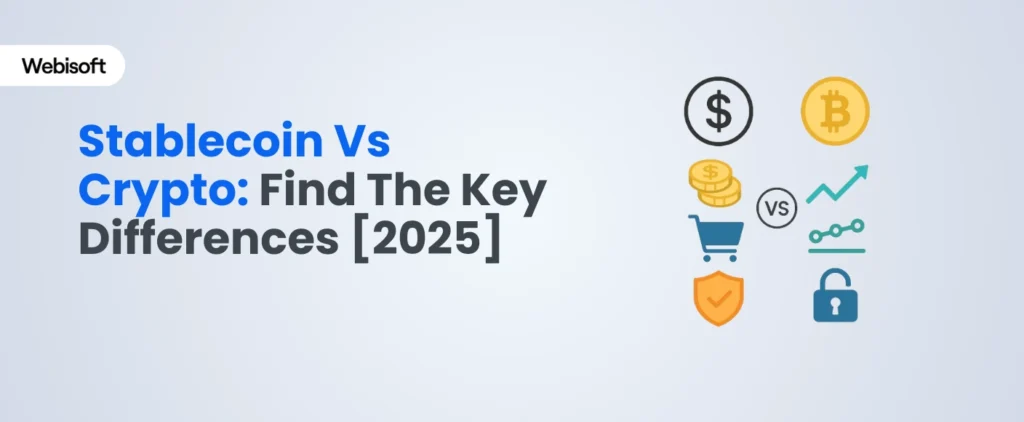The price changes in cryptocurrencies can be a big problem for businesses that need reliable digital payment solutions.
Fluctuating values can affect important transactions and cause cash flow problems, often challenging the prediction of costs. This instability makes it harder for businesses to fully trust and adopt cryptocurrencies.
On the other hand, stablecoins offer a solution by keeping their value linked to stable assets like the U.S. dollar. It makes them different from regular cryptocurrencies due to more predictability and security.
Keep on reading this effective stablecoin vs crypto guide and define the better choice for businesses that need stable transactions.
Contents
Crypto vs Stablecoins – Quick Comparison Table
Before we get into details, let’s have a quick glimpse at the comparison table to know how crypto and stablecoins differ from each other:
| Features | Stablecoins | Cryptocurrency |
| Value Stability | Pegged to an external asset (fiat, crypto, or commodity) to minimize volatility. | Value fluctuates based on market demand and supply, leading to high volatility. |
| Purpose | Medium of exchange, facilitating transactions, stability within the crypto ecosystem. | Store of value, speculative investment, potential for decentralized applications. |
| Centralization | Varies. Some are centralized (fiat-backed), others are decentralized (algorithmic). | Generally decentralized. |
| Use Cases | Daily transactions, remittances, DeFi applications, trading. | Long-term investment, store of value, potential for use in decentralized applications, and digital gold. |
| Regulatory Scrutiny | Growing Regulatory scrutiny due to ties to fiat currencies. | Varied regulatory scrutiny, depending on the region. |
| Examples | USDT (Tether), USDC (USD Coin), DAI (Decentralized) | Bitcoin (BTC), Ethereum (ETH), Litecoin (LTC) |
| Risk Level | Generally considered lower risk, though some forms (like algorithmic stablecoins) can be riskier. | Higher risk due to extreme market fluctuations. |
What are Stablecoins?
Stablecoins are specialized cryptocurrency that are designed to keep their value stable. They do this by connecting their value to something that doesn’t change much, such as the U.S. dollar or a valuable item like gold.
There are three main types of stablecoins:
- Fiat-backed
- Crypto-backed
- Algorithmic
Fiat-backed stablecoins are tied to currencies like the U.S. dollar, and other cryptocurrencies back crypto-backed ones. Algorithmic stablecoins use computer programs to control their supply.
To keep their price stable, stablecoins hold reserves of the asset they’re linked to or use programs that adjust with supply and demand.
This makes stablecoins a better option for daily use than regular cryptocurrencies. Stablecoins are becoming more popular, with over $162 billion in circulation.
What is Crypto?
Cryptocurrency, often referred to as “crypto,” is a type of digital currency that operates without the control of any central authority, like a government or bank. It provides an alternative way to make payments and is also used as a speculative investment.
Cryptocurrencies use cryptography, which is a method of secure communication, to ensure transactions are safe and private. When a transaction takes place, it is recorded on a blockchain, an unchangeable digital ledger.
Each user has two keys: a public key, which is visible to others, and a private key, which is kept secret.
Transactions are grouped in blocks, which are linked in chronological order to form the blockchain. This system ensures that past transactions cannot be altered, making cryptocurrencies a secure option for online payments and investments.
What Is The Difference Between Stablecoin Vs Crypto?

Have a detailed overview of how crypto and stablecoins are distinct from each other on different perspectives:
Volatility
Cryptocurrencies, such as Bitcoin, are known for their significant price swings, which can occur within a short period. This volatility makes them less predictable and more risky for everyday transactions or investments.
In contrast, stablecoins are designed to maintain a consistent value by being pegged to stable assets, such as a government currency or gold.
As a result, stablecoins experience far less price fluctuation. It makes them more reliable for daily use and a safer option for transactions compared to traditional cryptocurrencies.
Purpose
Cryptocurrencies primarily function as decentralized digital assets. They are often pursued for speculative investment or as a store of value.
These digital currencies are designed to operate independently of traditional financial institutions, creating a peer-to-peer system for electronic cash.
In contrast, stablecoins are created to reduce the volatility that is common with cryptocurrencies. Their primary purpose is to provide a stable digital currency, typically pegged to a fiat currency or a stable asset like gold.
This stability makes stablecoins ideal for everyday transactions, cross-border payments, and as a reliable medium of exchange within the digital asset ecosystem.
Mechanism
Cryptocurrencies work using blockchain technology, which is a digital ledger that records all transactions. They are decentralized, that means they aren’t controlled by any government or financial institution.
Their value changes based on supply and demand in the market, and investors can trade them for profit or hold them as investments.
On the other hand, stablecoins are designed to keep their value stable. They are usually linked or “pegged” to assets like a currency (such as the U.S. dollar) or something valuable like gold.
This peg helps prevent the big price swings that cryptocurrencies experience. Some stablecoins are backed by reserves of real money, while others use smart contracts and algorithms
It’s mainly due to controlling their supply and keeping the price steady.
Use Cases
Stablecoins and cryptocurrencies serve distinct purposes within the digital asset world. Cryptocurrencies are often used as long-term investments, where individuals buy and hold them with the hope of future value appreciation.
- They are also widely traded on exchanges for profit, making them a popular speculative asset.
- Additionally, cryptocurrencies serve as a foundation for decentralized applications and Web3 technologies.
- Though they can be used for value transfer outside traditional banking systems, their price volatility can limit their practicality for everyday transactions.
Stablecoins, on the other hand, are designed for stability, which makes them more suitable for real-world transactions. They are commonly used on cryptocurrency exchanges and decentralized finance platforms for seamless trading and liquidity.
- Their stable value also makes them ideal for cross-border payments and remittances. It’s a faster and more cost-effective transaction option compared to traditional banking.
- Businesses can accept stablecoins for payments without worrying about price fluctuations. Traders often use them as a safe option to preserve capital during market volatility.
Regulatory Scrutiny
The rules for cryptocurrencies and stablecoins are different in every country. Governments want to make sure people are safe when using them and that they don’t cause problems for the economy.
Cryptocurrencies work without banks, while stablecoins are made to keep a steady price. It’s usually pegged to a fiat currency like the US dollar (1 stablecoin = $1).
Cryptocurrency regulations:
Countries have different opinions on cryptocurrencies:
- United States: The government is keeping a close watch on cryptocurrency companies to make sure they follow the law.
- China: Cryptocurrency trading and mining are completely banned. The government says they can cause financial problems.
- Canada: People can trade cryptocurrencies, but they are not considered real money. There are rules to protect investors.
Stablecoin regulations:
Since stablecoins are meant to stay at a steady value, governments are making new rules to keep them safe:
- United States: Lawmakers are working on rules to protect people who use stablecoins and to make sure they don’t hurt the economy.
- European Union: New laws make sure stablecoin companies follow strict guidelines to keep the financial system safe.
Value Pegging
Most cryptocurrencies, like Bitcoin and Ethereum, rely on supply and demand. If more people want to buy, the price goes up. If more people sell, the price drops. Simple as that.
But there’s a problem—this makes their value swing wildly. One day, Bitcoin might hit a new high because investors are excited.
The next day, bad news or government rules could send it crashing. Things like market trends, tech updates, and regulations all affect prices fast.
That’s where stablecoins come in. They’re designed to keep a steady value by tying their worth to something else—usually a currency, another crypto, or a commodity. It avoids the extreme ups and downs of traditional cryptocurrencies.
Types of Stablecoin Pegging
- Fiat-Collateralized: These stablecoins are backed by real money, like the U.S. dollar. For example, every USDC token is meant to be backed by one actual dollar in reserve. This keeps its value stable.
- Crypto-Collateralized: These stablecoins are backed by other cryptocurrencies. Since crypto prices jump around a lot, these stablecoins usually hold extra reserves to cover price changes.
- Algorithmic: Instead of using reserves, these stablecoins rely on smart contracts and algorithms to control supply and keep their value steady. But this method can be risky because it depends on market trust and doesn’t have physical backing.
- Commodity-Collateralized: These stablecoins are backed by real-world assets like gold or other precious metals. Their value moves with the price of the commodity they’re tied to.
Stablecoins offer a way to avoid wild price swings, making them useful for payments, trading, and storing value. But the stability depends on the type of backing they use.
Stablecoins VS Crypto: Which One Is Best For B2B Payments?

When choosing between stablecoins and cryptocurrencies for business use, it’s important to consider factors like stability, cost, and speed.
Stablecoins
- Stability: Pegged to stable assets (e.g., U.S. dollar, gold) → Maintains consistent value
- Predictability: Ideal for businesses seeking stable and predictable transactions
- Faster Payments: Uses blockchain technology for quicker cross-border transactions
- Cost-Effective: Typically offers lower transaction fees for international payments
Risks:
- Regulatory uncertainty
- Financial stability of the issuing entity
Cryptocurrencies
- Decentralized: Operates without central control
- Lower Transaction Fees: Often cheaper for larger transfers
- Volatility: High price fluctuations make them less suitable for B2B transactions
- Scalability Issues: Can experience delays and higher costs during high demand
Risks:
- Price instability
- Unpredictable transaction times and fees
Conclusion
Stablecoins and cryptocurrencies each have their benefits.
For most businesses, stablecoins offer more stability and speed. Besides, cryptocurrencies can be more unpredictable but have higher growth potential.
All you need to do is get started and take the first step!
If you’re looking for a trustworthy provider to develop and manage your stablecoins or cryptocurrency, contact Webisoft today and get started.
We use advanced blockchain solutions, including stablecoin development, crypto payment integration, to make your transactions secure.
FAQs
When should I use cryptocurrencies instead of stablecoins?
Cryptocurrencies are better if you’re looking for potential growth through price fluctuations or if you’re investing for the long term. They’re also useful for decentralized applications.
Can stablecoins be used for saving or investment?
Yes, stablecoins can be used for saving or investment. They offer a safer option compared to other cryptocurrencies since their value is designed to remain stable.
Why do businesses use stablecoins?
Businesses use stablecoins for easier, faster, and cheaper cross-border payments. They also reduce exposure to the price volatility seen with other cryptocurrencies.
Are stablecoins a good choice for long-term investment?
Stablecoins are typically not designed for high returns, so they may not be ideal for long-term investments. They’re more suitable for short-term stability or preserving value.
